Reyna Gold samples up to 9.47% copper at La Gloria project, Mexico

Reyna Gold Corp. [REYG-TSXV; REYGF-OTCQB] reported more sample results from the continuing district-scale exploration at its 24,215-hectare La Gloria property in Sonora, Mexico. Results are returning high grades of precious, base, and critical metals, and substantially increasing the size of the mineralization footprints at Las Carmelitas, La Republicana and Western targets.
Main Area “Potential Enrichment Zone” at Las Carmelitas expanded to 1km length by 250 metres average width. Major Conglomerate and Agglomerate Zone discovered at Las Carmelitas 2.5km length by 1.7km average width.
Disseminated mineralization identified within Conglomerate, Agglomerate, and Sandstone host rocks at Las Carmelitas. New La Republicana North Zone discovered, expanding known mineralization footprint at La Republicana to 2.67 km2 (267 hectares).
Western target mineralization footprint expanded to 1.5km length by 450 metres average width, with high grades of tellurium found throughout the Western mineral system
“Our Geoscientific exploration approach continues to work, and the more we explore La Gloria, the more excited we get about its potential. The known size of the mineral systems at our main targets are now all multiple square kilometres,” said Michael Wood, CEO. “We are delighted to find disseminated mineralization in the conglomerate, agglomerate, and sandstone host rocks at Las Carmelitas. This is a great breakthrough for our exploration at Las Carmelitas, giving us the potential to achieve significant bulk tonnage mineralization close to surface. We are also excited to find high grades of two major critical metals: Antimony in the Las Carmelitas System and Tellurium in the Western System.”
Ariel Navarro, VP Exploration, commented, “The size of the conglomerate at Las Carmelitas and the highly silicified nature of the matrix within the conglomerate is beautiful to see from a geological perspective. The presence of the unique geochemical assemblage (Antimony, Mercury, Barium, and Strontium) found in enrichment zones, along with the presence of minerals that are great hosts for high-grade Copper and Silver, (Chalcocite, Malachite, Azurite and Stibiconite) in the favorable host rocks (conglomerates, agglomerates, and medium-gain sandstones), indicates the potential for an enriched zone of great amplitude that is at the top of a major mineral system.”
Sample Highlights: Las Carmelitas: 9.47% Copper, 202.00 g/t Silver, 1.68 g/t Gold, and 0.26% Antimony; 7.03% Copper, 272.00 g/t Silver, 0.30 g/t Gold, and 0.42% Antimony; 4.38% Copper, 177.00 g/t Silver, and 2.44% Antimony;4.34% Copper, 123.00 g/t Silver, 0.25 g/t Gold, and 0.23% Antimony; 3.54% Copper, 134.00 g/t Silver, 0.20 g/t Gold, and 1.24% Antimony; 3.44% Copper, 198.00 g/t Silver, 0.13 Gold, and 1.65% Antimony; 3.31% Copper, 64.80 g/t Silver, and 0.13 g/t Gold; 11.35 g/t Gold and 50.80 g/t Tellurium as well as 27.00 g/t Silver and 135.00 g/t Tellurium. Refer to original press release for complete assay results.
La Republicana: 11.90 g/t Gold, 107.00 g/t Silver, and 0.32% Lead, 4.29 g/t Gold, 0.18% Copper, and 0.14% Lead; 2.37 g/t Gold, 90.40 g/t Silver, and 5.33% Lead; 1.22 g/t Gold, and 28.40 g/t Silver; as well as 0.28 g/t Gold, and 1.03% Copper.
At the Las Carmelitas target, multiple high-grade samples up to 9.47% Copper (Cu), 272 g/t Silver (Ag), and 2.44% Antimony (Sb), and high grades of Mercury (Hg), Barium (Ba), and Strontium (Sr) have been received, adding to the thesis they identify a supergene enrichment zone at the top of a mineral system at Las Carmelitas. In total, 43 samples have been taken in the main area of Las Carmelitas with average grades of 2.25% Copper, 89.14 g/t Silver, 0.21 g/t gold, and 0.48% Antimony.
The discovery of multiple Antimony samples of more than 1% up to 2.44% is a very positive addition to the potential of Las Carmelitas. Antimony is on the United States Critical Mineral List and is a critical mineral for producing semiconductors, electric storage batteries, fire retardants and bullets.
Reyna Gold’s geological team is working on a trenching program and an IP geophysical survey in the Las Carmelitas Target to more clearly determine the size of the potential supergene enrichment zone and identify the potential of the system at depth.
At the Western target, the mapping and sampling work has focused on initially developing a core area. The geological team has discovered new parallel structures and the continuation of those previously reported within the northeast-southwest trending system. In addition, secondary trending structures northwest-southeast, east-west, and north-south have been identified. The footprint of the core target area now has a length of 1,500 metres and a 450 metres average width; the system is open, both longitudinally and transversally.
Tellurium is also on the United States Critical Minerals List and is used in manufacturing solar panels and thermoelectric devices.
At the La Republicana Target, mapping and sampling continued in the core northwest-southeast trend zone, where previously reported drill-hole 30 produced a 59 metres of 1.45 g/t gold intercept.
La Republicana North has been discovered north of the main target area with the same host rocks, meta-rhyolite and meta-andesite (rocks favorable for mineralization).
In La Republicana North, a zone of parallel and semi-parallel veins and veinlets has been identified with a length of 570 m and an average width of 480 metres, with grades of up to 18.95 g/t Gold, 199 g/t Ag Silver, 1.03% Copper and 5.33% Lead.
The three zones of La Republicana now total 2.675 km2, with grades of up to 103.50 g/t Gold, 283.00 g/t Silver, 2.4% Copper, 5.33% Lead, and 0.12% Zinc.
The company is preparing to resume diamond drilling at La Republicana Target and start initial drilling at Las Carmelitas and Western Targets once interpretations of the Induced Polarization (IP) geophysics are incorporated into the drill target model. Drilling will resume in early March.
A trenching program has also started at Las Carmelitas.
Mapping and sampling are continuing in Western and La Republicana Targets to increase the size of mineral footprints at surface.
